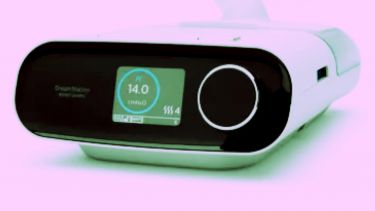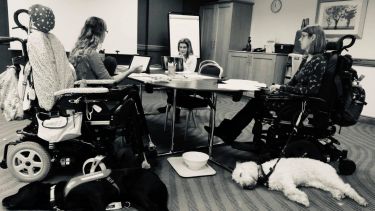Hello, Betty!
I want to begin this short post by introducing you to Betty. Betty is my ventilator - a BiPAP - which stands for bilevel positive airway pressure. Betty Bipap (as she’s also known) is very clever. She pushes room air into my lungs as I sleep to improve the levels of oxygen in my blood and reduces the amount of carbon dioxide that I can no longer ‘process’ or expel independently.
Now, I first met Betty in 2015, following a routine sleep study which revealed that my oxygen saturation was dropping over 30 times a night. A consultant handed Betty to me and told me to go home - “it’s easy to use” she said, “this is the on/off button”. A life-changing moment.
I tried Betty that night, but it didn’t work for me. She was really uncomfortable and made me physically sick. I popped Betty under the bed and wouldn’t meet her again for another two years, by which point I was an inpatient with severe heart failure.
I was lucky, though - I had a bed with a window and enjoyed the NHS tea. I stayed for 3 weeks, undergoing intensive inpatient training to learn how to use Betty. I soon returned home - heart no longer failing - but only under the promise that collaborating on breathing with Betty during the night would be my new reality for the rest of my life.
But this is only Betty’s clinical story. And these clinical stories are already relatively well-known. So too are the dominant cultural understandings of what we think we know about the lives of those who live with ventilation. The idea that being on ventilation means one is near end-of-life; has a failing or ailing body; and ultimately, a life of lesser value.
In actual fact, my human story of Betty’s presence is far more affirmative - rather than being close to death, she enables life. I’m a Mum, partner, daughter, carer, and academic. Betty is a tool, a friend, my travel companion, and the ultimate forbidden toy to my toddler. Like me, she has a life outside of the clinic and the clinical.
This post has begun with my own narrative to affirm the ways in which human stories of disability and illness are deeply valuable: how they counter dominant ways of knowing and offer new lenses to inform respiratory healthcare. I now want to move on to outline Cripping Breath, a new University of Sheffield co-produced research project that has recently received a Wellcome Trust Discovery Award.
Cripping Breath: Thinking past Betty
Betty is just one form of respiratory technology and mine is just one story. According to NICE, respiratory disease affects 1 in 5 people (NICE 2020). As such, Cripping Breath centres the lives of people who have had their lives saved and/or sustained by ventilatory medical technologies. This includes a diverse population of people with a wide range of health conditions, including neuromuscular and neurological conditions, COPD, Motor neurone disease (MND), asthmas and more. Our explorations will be led by disabled, chronically ill and ventilated people, in recognition that these growing communities of people and patients are often absent from contemporary social theorisations of respiration and ventilation, but also that their experiences have much to teach about living in cultures of compromised respiration.
Beyond these quite specific engagements with respiratory health, our project is important because we are living in a respiratory age that needs urgent analyses of what we’ve called a ‘new cultural politics of respiration’. According to Allen (2020: 80) ‘breathing, as the practice that connects bodies to air, is undertheorized or overlooked’. The primitive act of breathing is inevitably something that we take for granted, ‘yet in the midst of the Covid-19 pandemic, compromised respiration is now at the forefront of everybody’s minds’ (Fitzharris 2020; np). Notably, we are at a point in history where respiration is now pulled into view more than ever before. This is undeniably through Covid-19 as a (continuing) global public health crisis, but also through climate crises, and increased pollution and ecological degradation, which are affirming a population-wide debility around respiration (Puar 2017).
Thus, Cripping Breath centres respiratory health, but does so in a broader context that is worthy of attention. To give some timely examples: the first is how we are recovering from Covid-19, and how we are managing our everyday risk of infection: masks, Co2 monitors, vaccine equity, and Long Covid. Secondly are global climate crises. In 2021, the World Health Organization declared air pollution the world’s biggest public health crisis (WHO 2021). Thirdly is social deprivation and respiratory health. We’ve seen recently how the death of Awaab Ishak has shed light on a social housing scandal and how Ella Kissi-Debrah became the first person in the UK to have air pollution listed on her death certificate. And now, more recently, we are amidst energy and cost of living crises whereby many disabled people are struggling to afford to run the very medical equipment that keeps them alive.
Breathing, then, is far from only autonomous and automatic. It is a social, political and embodied process which speaks to the need for inquiry that is inclusive of gender, race, class, age, disability, and nationality within conversations about respiratory health - both in an ongoing pandemic and as we look to post-pandemic futures.
Cripping Research: embracing Crip and co-production
In order to acknowledge and situate disabled, chronically ill and ventilated people as knowledge producers, theoretical provocateurs, artists and researchers - a key research aim - Cripping Breath will develop Crip methodologies, which have the potential to drive positive and inclusive research cultures. Our Research Team (which will grow as the project gets underway) centres disabled and chronically ill collaborators, many of whom are long-term users of forms of ventilation. For us, this lived experience embodies the politics of Crip - infusing the disruptive potential of disability into the normative spaces and interactions of research inquiry. As such, those typically excluded from research processes and knowledge production take centre stage (see Whitney et al. 2019).
Furthermore, our approaches to co-production are supported by our brilliant partner organisations: CRIPtic Arts, Pathfinders Neuromuscular Alliance, The Art House, and Sheffield Teaching Hospitals. Co-produced research ‘aims to put principles of empowerment into practice, working “with” communities and offering communities greater control over the research process’ (Durose et al. 2012: 2). By extension, then, for Cripping Breath research is not a process about people with respiratory conditions, but conducted with and by them (Fudge et al. 2007). Co-production can be a contested field, but we purposefully make space for unknowing and uncertainty, letting research relationships with disabled and chronically ill people and partners lead, with the aim that they take ownership of the research in ways unforeseeable at this juncture (see Liddiard et al. 2019; Liddiard et al. 2022).
The project’s transformative potential emerges, then, in centring ventilated people’s lived and embodied knowledges in existing theories of respiration and breathing for the first time. Our inquiry develops a new cultural politics of respiration in a time of new histories of ventilation emerging during an ongoing pandemic. Crip perspectives offer a sitpoint that emerges from disability studies and activism and which unapologetically centres disability and chronic illness as valued human experiences. Across four distinct streams of inquiry our project positions Crip perspectives as the very driving subjects of disability arts expression and curation, inclusive methodologies and scholarly transformation and equitable theory-building with, rather than on, marginalised communities. Ultimately Cripping Breath acknowledges the ways disability and chronic illness offer ‘alternative ways of conceptualising the human subject’ (Braidotti 2012: 37) currently omitted in existing scholarship surrounding breathing, respiration and ventilation. To give you a flavour of the methods Cripping Breath will employ:
- In our narrative stream, our expert-by-experience co-researchers will employ virtual narrative methods to capture participants' everyday lived stories of ventilation;
- In the archival stream, we will spend 6 months with the Wellcome Collection, virtually exploring archives of respiratory medicine to rewrite ventilatory histories from the perspectives of marginalised people;
- In our arts stream, participants will work with the projects Artists-in-Residence Jamie Hale and Louise Atkinson via accessible and hybrid workshops, to co-curate artistic data via research-informed theatre and visual arts approaches;
- And in the ethnographic stream, patient-led clinical ethnographies at Sheffield Teaching Hospitals will 'follow' respiratory technologies from clinics to the home to explore clinicians' and patients' negotiations of ventilator practice over time.
Moreover, we’ve designed the project so that each stream offers distinct forms of data while committing to responsive, flexible, hybrid, slower and Covid-safe approaches - to work accessibly and inclusively together.
Conclusion
To end here, then, Cripping Breath radically positions disability and chronic illness as productive, creative and disruptive. Our project builds critical transdisciplinary scholarship around the lived realities of ventilation to explore a new cultural politics of respiration in a pandemic age. But to do so, the project places people with lived experience at the very heart of inquiry - to change the ways in which research typically happens. This means being experimental, innovative and bold. Our desire is for the highest quality scholarship that is radical in its research leadership: to explore what happens when disabled, chronically ill and ventilated people come together to coproduce theory and knowledge. We are very proud, as a Research Team, to have co-designed a project that truly values disability and chronic illness as the driving subjects of research and innovation - this is Cripping Breath.
References
Allen, I. K. (2020) ‘Thinking with a Feminist Political Ecology of Air-and-breathing-bodies’, Body and Society, 26: 2, 79–105
Braidotti, R. (2012) The Posthuman. London: Polity.
Durose, C., Beebeejaun, Y., Rees, J., Richardson, J., Richardson, L. (2012) Towards
Coproduction in Research with Communities. AHRC: Swindon, UK.
Fitzharris, L. (2020) A brief history of ventilation. Online. Available from:
https://wellcomecollection.org/articles/XvslwhQAAO0l0Q4V. Accessed 23/9/2021
Fudge, N., Wolfe, C.D.A., McKevitt, C. (2007) ‘Involving older people in health research’, Age and Ageing, 36: 492– 500.
Liddiard, K., Runswick-Cole, K, Goodley, D., Whitney, S., Vogelmann, E. and Watts, L. (2019) ‘“I was excited by the idea of a project that focuses on those unasked questions”: CoProducing Disability Research with Disabled Young People‘, Children and Society, 33: 2, 154- 167
Liddiard, K., Goodley, D., Runswick-Cole, K., Whitney, S., Vogelmann, E., Watts, L., Aimes, C., Evans, K. and Spurr, R. (2022) Living Life to the Fullest: Disability, Youth and Voice. Bingley: Emerald Publishing
Nice (2020) NICE impact respiratory conditions. Online. Available from: https://www.nice.org.uk/about/what-we-do/into-practice/measuring-the-use-of-nice-guidance/impact-of-our-guidance/nice-impact-respiratory-conditions#:~:text=Respiratory%20disease%20affects%201%20in,NICE%20guidance%20on%20respiratory%20conditions. [Accessed 12/12/2022]
Puar, J. K. (2017) The Right To Maim: Debility, Capacity, Disability. Durham, NC: Duke University Press
Whitney, S., Liddiard, K., Goodley, D., Runswick-Cole, K., Vogelmann, E., Evans, K., Watts (MBE), L., and Aimes, C. (2019) ‘Working the edges of Posthuman disability studies: Theorising with young disabled people with life-limiting impairments’, Sociology of Health and Illness, 41: 8, 1473–1487







